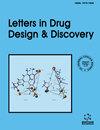氟康唑微乳剂:制备、通过两级因子设计进行统计优化以及理化评价
IF 1.6
4区 医学
Q4 CHEMISTRY, MEDICINAL
引用次数: 0
摘要
背景白色念珠菌是导致真菌感染的酵母菌,被称为念珠菌病。治疗念珠菌病的标准方法之一是使用氟康唑。氟康唑在水介质中的低溶解度是使用这种药物的一个大问题。微乳剂等新型给药系统可用于解决这一问题。本研究的主要目的是对氟康唑微乳剂的配方和理化特性进行统计优化。方法::使用实验设计软件对微乳剂配方进行优化,然后将氟康唑以 1 % w/w 的浓度添加到最佳配方中。通过 pH 值测量、流变学测量、同步热分析和扫描电子显微镜(SEM)评估了微乳剂配方的理化性质。结果两级分数因子设计应用表明,最佳配方由表面活性剂、辅助表面活性剂、油含量和水组成,分别占配方的 58%、27%、10% 和 5%。观察到理想的热质量可达 150°C。该配方的粘度为非牛顿剪切稀化液体,pH 值在 6.5-7 之间:本研究提出了含有氟康唑的相当稳定的高质量微乳剂配方,可用于临床试验中的皮肤念珠菌病抗真菌治疗。本文章由计算机程序翻译,如有差异,请以英文原文为准。
Fluconazole Microemulsions: Preparation, Statistical Optimization by Two-Level Factorial Design, and Physicochemical Evaluation
Background:: Candida albicans is the yeast that causes the fungal infection known as candidiasis. One of the standard methods for treating candida is the application of fluconazole. The low solubility of fluconazole in aqueous media is a big problem in the use of this agent. Novel drug delivery systems, such as microemulsions, could be applied to solve this problem. The main aim of this study was to perform statistical optimization of the formulation and physicochemical characterization of fluconazole microemulsion. Methods:: Optimization of the microemulsion formulation was done by using experimental design software, and then fluconazole was loaded onto the best formulation at a concentration of 1 % w/w. The physiochemistry of the microemulsion formulation was assessed by pH measurement, rheology measurement, simultaneous thermal analysis, and Scanning Electron Microscopy (SEM). Results:: The two-level fractional factorial design application demonstrated the optimum formulation to consist of surfactant, co-surfactant, oil content, and water, comprising 58%, 27%, 10%, and 5% of the formulation, respectively. Desirable thermal mass was observed up to 150°C. The formulation was a non-Newtonian shear-thinning liquid in terms of viscosity, with a reported pH between 6.5-7. Conclusion:: Considerably stable, high-quality microemulsion formulations containing fluconazole are presented, which are applicable for antifungal skin candidiasis treatment in clinical trials.
求助全文
通过发布文献求助,成功后即可免费获取论文全文。
去求助
来源期刊
CiteScore
1.80
自引率
10.00%
发文量
245
审稿时长
3 months
期刊介绍:
Aims & Scope
Letters in Drug Design & Discovery publishes letters, mini-reviews, highlights and guest edited thematic issues in all areas of rational drug design and discovery including medicinal chemistry, in-silico drug design, combinatorial chemistry, high-throughput screening, drug targets, and structure-activity relationships. The emphasis is on publishing quality papers very rapidly by taking full advantage of latest Internet technology for both submission and review of manuscripts. The online journal is an essential reading to all pharmaceutical scientists involved in research in drug design and discovery.

 求助内容:
求助内容: 应助结果提醒方式:
应助结果提醒方式:


